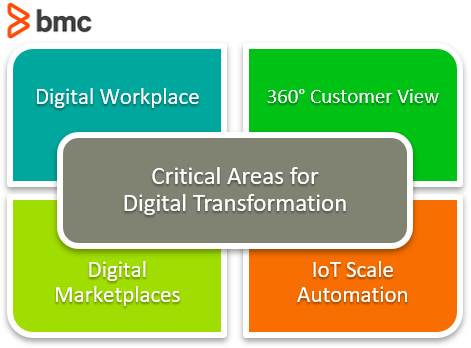In the past decade, discussion around digital transformation has grown. This year, 2020, has made digital transformation more than a nice idea. DX has become imperative to business survival in the age of remote work. Organizations that have not adopted a digital first strategy are unlikely to see the end of 2021, at best.
So, how do organizations manage these all-digital services, especially when we’re not in the office? Let’s take a look at digital service management (DSM).
Today’s digital services
Digital services are very different from the IT services of the past. They are expected to:
- Work on mobile
- Have a highly intuitive design
- Evolve at a speed and operate at a scale we have never seen in traditional IT
Today, people need to be productive on a whole new level, so having information that’s relevant to what they are trying to do wherever they are is a must. A digital business can compete with human productivity and provide efficiency gains that are truly spectacular.
There are four critical areas where organizations are embracing digital innovation:

These four areas also illustrate how traditional ITSM must shift to digital service management.
Digital workplace
The ability to work anywhere, anytime is no longer just something nice to have. Enabling work from anywhere is an essential tool for virtually every organization for at least some, if not a majority of, functions. Businesses that had not put digital workplace solutions in place found themselves scrambling at the beginning of 2020 to mobilize their workforce’s and allow them to not only connect to the workplace from any location, but to work efficiently with little or no reduction in productivity.
For service management workers, this meant being able to use their service management toolset, with the same functionality, speed, and automation at home as they can from behind an office desk.
360° customer view
Companies need to seamlessly service customers regardless of channel—sales, marketing, and customer support. To make this work, IT must be fully integrated with all digital customer channels. Changes in customer behaviors make this view even more imperative as physical interactions decrease and engagement via alternative digital channels rise.
Digital marketplaces
Ten years ago, the digital marketplace was an add-on, providing an additional channel for customers. Such marketplaces added a small percentage to revenues. As we moved through the twenty-teens, the digital marketplace grew rapidly in importance, with companies such as Amazon and eBay securing prime positions in this new way of selling.
Fast-forward to 2020 and companies with no established place within the digital marketplace have found themselves in the position of having to rapidly play catch-up or fade into oblivion. Many long-established businesses with predominantly a brick and mortar presence have fallen victim to 2020, while Amazon has reportedly had its best year on record.
Internet of Things (IoT) scale automation
The automation of IT has always been a core focus for the service management industry. Now we are seeing digital innovation well beyond the firewall and data centers of our customers—the internet of things. The IoT is rolling out across all industries with tools like:
- Point-of-sale devices
- Energy pipelines
- Healthcare biometric devices
In a world where your refrigerator can automatically order goods that you have run out of and your television suggests new shows based on your previous viewing behaviors, service management solutions must now manage the scale of assets and touch points with a service measured in the trillions of devices.
Changes for service management
Moving from a conventional service management ecosystem to digital service management will necessitate some changes in the way we work:
- DSM will involve service management in becoming predictive. We need to harness the power of new technologies such as AI and machine learning in order to proactively support the digital workplace. This emerging field is known as AIOps.
- Technology will initiate many of the calls on service management. This is particularly obvious in the way we will deal with abnormal events in service operations. We no longer have to wait for someone to notice a service degradation. Instead, technology will identify and remedy the situation before it impacts customers.
- Customers will increasingly interact with chatbots and virtual agents. This frees up your people to work on more complex issues and explore innovation opportunities
- Our tiered support model of escalation is likely to be superseded by a more direct model of support. In this new model, issues that cannot be resolved automatically are detected and automatically diverted to the most appropriate human resource for resolution.
Innovation and rapid delivery are differentiators
Being able to innovate constantly and rapidly deliver new and exciting digital services will be the differentiator for the companies of today and the future. Our ability to effectively and efficiently support services in this digital world will be the differentiator that separates the winners from the losers in a race to complete digital transformation.
Become an Autonomous Digital Enterprise
Empowered by digital transformation, organizations can be on their A-game and evolve to become an Autonomous Digital Enterprise, a forward-looking vision of the future state of business that embraces intelligent, tech-enabled systems across every facet of the business to thrive during seismic changes.
ADE organizations continuously evolve and stay competitive in an ever-shifting world—just as we’ve seen this year. Autonomous Digital Enterprises rely on five key tenets:
- Delivering a transcendent customer experience
- Applying automation everywhere
- Supporting enterprise DevOps
- Driving data-driven business outcomes
- Safeguarding through adaptive cybersecurity
To enable your remote workforce with the digital services your customers expect, explore BMC Helix. BMC Helix uses cognitive automation technologies to transform best-practice ITSM principles giving you the tools you need to deliver predictive, industry-leading service management in a digital first world.
Additional resources
For more on modern service management, explore these resources:







